
Cryptocarya laevigata, known as the glossy laurel or red-fruited laurel, is a rainforest plant growing in eastern Australia. The natural range of distribution is rainforest understorey on fertile soils, from the Richmond River, New South Wales to Cairns in tropical Queensland. Often seen in association with the White Booyong.
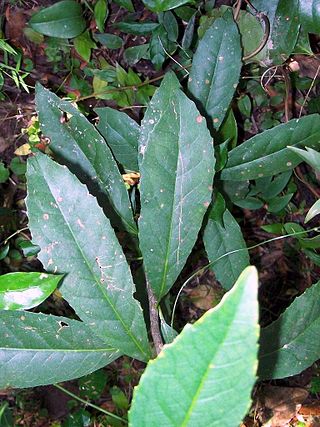
Symplocos thwaitesii, or the buff hazelwood, is a rainforest tree growing in eastern Australia. Seen in tropical, sub-tropical and warm temperate rainforests, often in gullies. Occasionally it grows in cooler situations such as at Monga National Park.

Croton verreauxii known as the green native cascarilla is a small tree or shrub growing in dry rainforest and rainforest margins in eastern Australia.

Psychotria loniceroides, the hairy psychotria, is a plant native to the forest areas of eastern Australia.

Notelaea venosa is a very common shrub or small tree in eastern Australia. Occurring in or adjacent to rainforest from Lakes Entrance, Victoria to Cunninghams Gap in south eastern Queensland. Common names include veined mock-olive, smooth mock-olive, large-leaved mock-olive and large mock-olive. Often seen in the bushland areas in Sydney.

Clerodendrum tomentosum, known as the downy chance, hairy lolly bush, hairy clairy or hairy clerodendrum is a shrub or small tree occurring in eastern and northern Australia. Distributed from Batemans Bay in southern coastal New South Wales, Queensland, Northern Territory, Western Australia, and New Guinea.

Maytenus silvestris is a shrub or small tree growing from Picton, New South Wales near Kroombit Tops, near Gladstone, Queensland. It occurs in dry rainforest, eucalyptus and rainforest ecotone areas. Common names include narrow leaved orangebark, orange bush and orange bark.

Elattostachys nervosa, known as the green tamarind or beetroot tree is a common rainforest tree of eastern Australia. Found in all types of rainforest, growing from Paterson, New South Wales in the south to Gympie in south east Queensland. The name Elattostachys refers to "little spikes", a flower feature of other plants in this genus. Nervosa refers to the prominent leaf venation. Beetroot Tree refers to the beetroot red leaves of the new growth.

Ficus virens var. sublanceolata is a banyan or strangler fig. It grows alongside the related white fig in the northern part of its range. They differ with narrower leaves, almost lanceolate in shape. Common names in Australia include white fig, sour fig, deciduous fig and banyan. A large example can be seen north of Murwillumbah beside the old Pacific Highway, not far from the state border with Queensland.

Cryptocarya bidwillii, the yellow laurel, is a small to medium-sized tree in the laurel family. Occurring in Australian rainforests from Nymboida in the state of New South Wales to Townsville in tropical Queensland. Often found in the dryer ridges in dry rainforest or in viney scrubs.

Mallotus philippensis is a plant in the spurge family. It is known as the kamala tree or red kamala or kumkum tree, due to the fruit covering, which produces a red dye. However, it must be distinguished from kamala meaning "lotus" in many Indian languages, an unrelated plant, flower, and sometimes metonymic spiritual or artistic concept. Mallotus philippensis has many other local names. This kamala often appears in rainforest margins. Or in disturbed areas free from fire, in moderate to high rainfall areas.
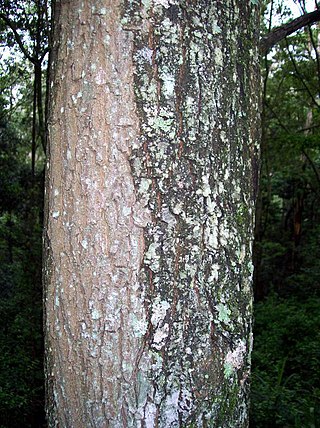
Bridelia exaltata, known as the brush ironbark or scrub ironbark, is a tree of eastern Australia. It occurs in and on the margins of the drier rainforests. Also occurring by streams, often in association with the Black Bean, up to an elevation of 600 metres above sea level. It occurs from Seal Rocks, New South Wales to Maryborough, Queensland.

Alchornea ilicifolia, commonly known as the native holly is a bush of eastern Australia. Growing in or on the edges of the drier rainforests, from Jamberoo, New South Wales to Atherton, Queensland.
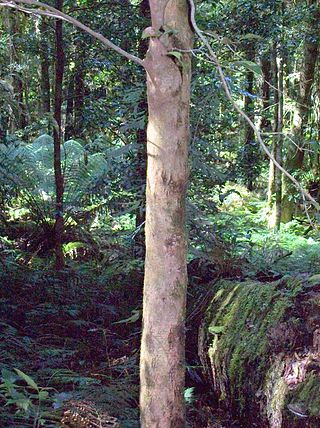
Gossia acmenoides, known as the scrub ironwood, is a rainforest tree of the family Myrtaceae, native to eastern Australia. The usual habitat of this small tree is drier rainforest areas. The range of natural distribution is from Jamberoo in New South Wales to Eungella National Park in northern Queensland.

Cinnamomum virens is a rainforest tree growing in the eastern coastal parts of Australia. Common names include red-barked sassafras, black sassafras, camphorwood, scentless cinnamon wood, and native camphor laurel. Its habitat is between the Williams River and the Main Range National Park in Queensland. Growing in rich volcanic soils or on the poorer sedimentary soils, it is often in association with coachwood.
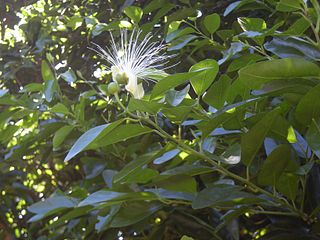
Capparis arborea is a bush or small tree occurring in eastern Australia. The habitat is rainforest; usually riverine, littoral or the drier rainforests. Distributed from the Hunter River, New South Wales to Cape Melville in tropical Queensland. Common names include native pomegranate, wild lime, wild lemon and brush caper berry.

Cupaniopsis baileyana is a species of flowering tree in the soapberry family. It is native to eastern Australia. Common names include White Tamarind and Toothed Tuckeroo. The species name honours the botanist F.M.Bailey.
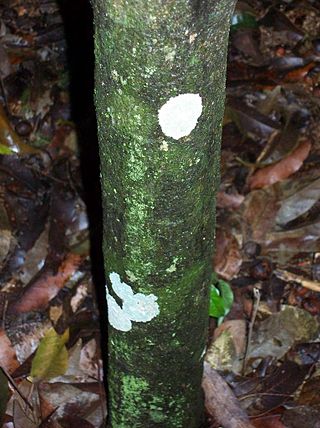
Ochrosia moorei, known as the southern ochrosia is a rainforest plant of eastern Australia. Endangered by extinction, it has a ROTAP rating of 2ECi.

Decaspermum humile, commonly known as the silky myrtle, is a tree from Australia and Asia. It can be used as bush food, as indicated by the alternate common name of currant myrtle. The tree features an attractive dark glossy crown. The new pink leaves with silvery hairs are particularly appealing.

Triflorensia cameronii is a very rare rainforest plant of the coffee family, growing in a few areas of eastern Australia. Found in Lismore, New South Wales as well as a few other locations in nearby Queensland. Soils are based on basalt, and the rainforest is the drier type, with hoop pine nearby.



















